Note: This review was originally written in december 16th, 2016. I’ve kept the original text and added a new topic at the end regarding the changes from multiple patches and updates.
At last.
The wait was almost infuriating, much longer than any of us expected. When Final Fantasy XV was announced, still as Final Fantasy Versus XIII, the Playstation 3 was just out of the oven and priced at the ridiculous 600 dollars tag, there was no Final Fantasy XIV fiasco and rebirth, there was no Lightning and her three games, no one would even have the slightest clue to how powerful the distant Playstation 4 would be. Here we are though.
Final Fantasy XV starts with a message from Square Enix: “A Final Fantasy for fans and first-timers”, an important message in a franchise that gathered fervorous fans in the SNES and Playstation eras and saw its legacy suffer in following generations, with negative criticism and a certain amount of exaggeration from a portion of nostalgia-afflicted fans who grew old and did not care much about the current course of the japanese video game industry. Anyway, is this really a game for fans and people who never played a single game in the franchise? That’s difficult to answer right away.
First, Final Fantasy XV is a technically excellent game. It remembers the hits and misses from Final Fantasy XII, a game that utilized every drop of power the Playstation 2 had to offer and was so stunning it could very well be a Playstation 3 game, but suffered a lot in many other aspects. Final Fantasy XV hits and misses are many, as I will try to discuss.
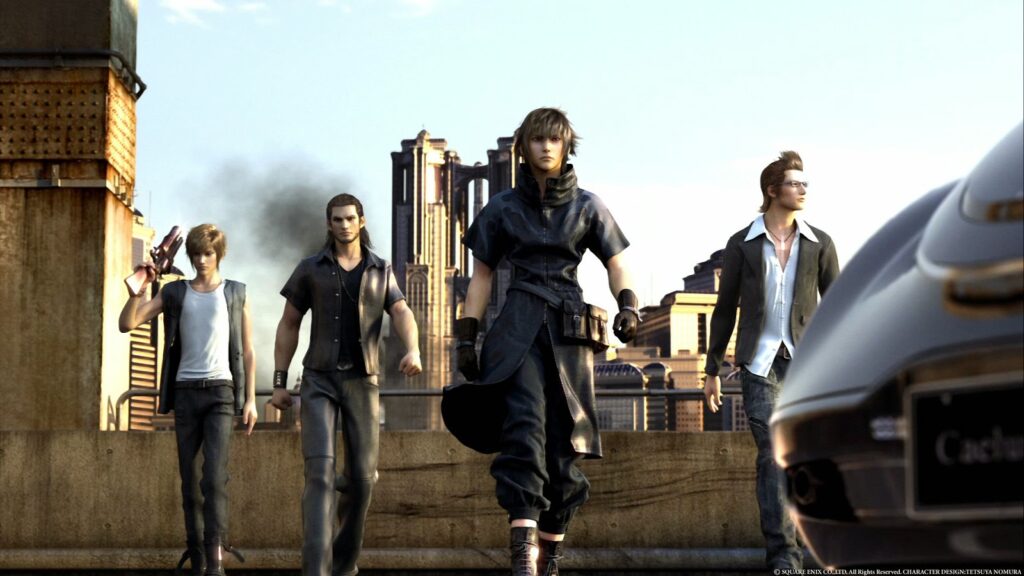
Characters?
Well, Final Fantasy XV is harmed by two extremes when it comes to its cast. The four “bros” (Noctis, Gladios, Ignis, and Prompto) combine for a charismatic group of adventurers, old friends who constantly tease each other and make funny jokes about their situation, even in dire moments. As the game progresses, this friendship deepens, story events take the four guys to a variety of situations, and their initial stereotypes manage to be lightly broken and improved. For those who thought that the “road trip” aspect of the game with four dudes would be a negative, what happens is exactly the opposite, this becoming perhaps the strongest aspect that the Final Fantasy XV experience delivers. The same cannot be said about the side characters though.
Yeah, poor side characters
So much hate was given to Final Fantasy XIII due to its lack of a single living soul in the path taken by Lightning and her friends. There was nobody to talk to, the world was empty, inhabited only by the heroes and the forgettable villains. Final Fantasy XV right this wrong with a populous world, people walking around small towns and outposts, diner cooks giving you hunting missions and food, country-girl Cindy fixing your car and upgrading it. There’s a lot of people related to the main quest too, such as young Iris, the immortal Corr, the seductress Aranea, and the villains from Niffelheim. The casting nails the quantity and importance of each character, sadly though there is almost nothing to explore these mysterious allies and foes.
There is no interaction with any side character out of the short periods of time where you meet them during the course of the story. Corr? He delivers you a main quest early on and vanishes until he comes back for a single photo. Cindy and Cid? They help you twice, beyond that they only give you side-quests to kill monsters and collect random items. Aranea? One battle, one dungeon, and a short dialogue close to the game’s final. Ravus? Oh, poor Ravus… Luna? Ah, Luna … thankfully there is Kingsglaive, because even though she is the heroine, you’re more likely to remember Cindy giving you endless quests rather than the existence of Noctis’s bride.
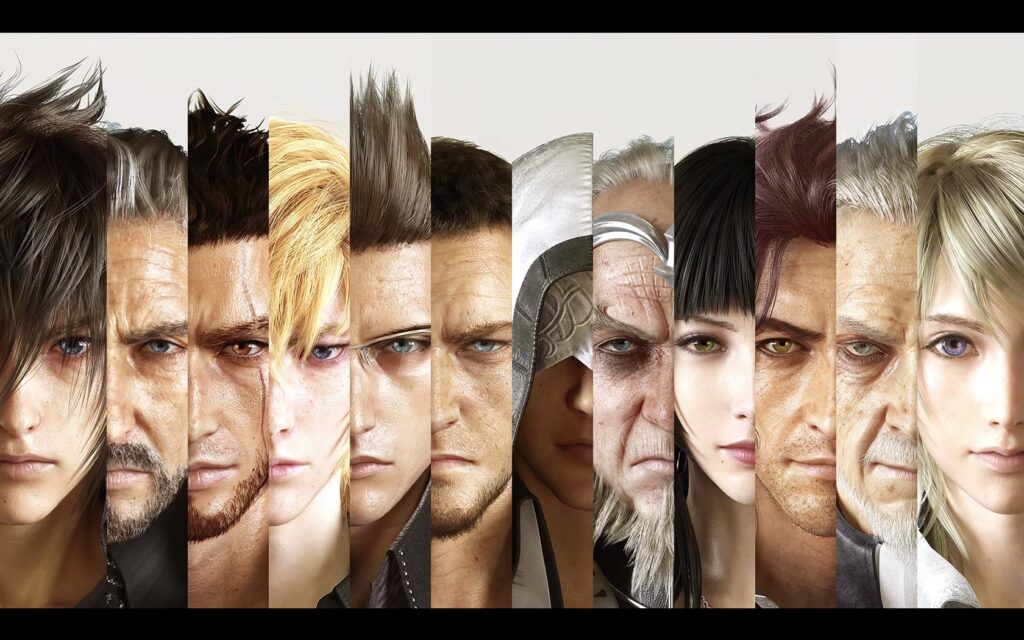
The three “bro” allies also suffer with this lack of interaction. There is no casual dialogue to be had, you cannot stop them to start random conversation, there are no exclusive missions for them (this will be restricted to DLC), there not much to explore these guys other than a few optional events happening when you camp at some predetermined locations. There is a critical lack of options for you to know the side characters and your allies better, to understand their motivations, to explore their personalities and nuances. Only the main quest events show you some new facets to the people around Noctis, and these basically limit themselves to Gladios, Ignis, and Prompto.
The big Void
The open world filled with areas to explore, roads to travel while listening to classic soundtracks of the series, and a multitude of optional quests are a welcoming sight when you start playing Final Fantasy XV. The world does look immense and with a lot to do. However, as you play for a few hours, you can see this only follows the traditional japanese standard for open worlds: plenty of repetition, fetch quests, hunting quests, and simple tasks to travel from point A to point B. Other than that, the map is a vast emptiness. Even the main quest suffers with this huge farmland in its first half, only occasionally saved by its important dialogues that manage to contribute to world building, stuff that simply none of the side quests do.
At the end, what we have is a beautiful map to explore, intriguing locales to visit, and some wonderful scenery, but the quests are always the same. After visiting a certain place, you are unlikely to feel motivated to visit it again when a new optional quest asks you to return there. You know you will only be killing random mobs and will learn nothing new in this second trip.
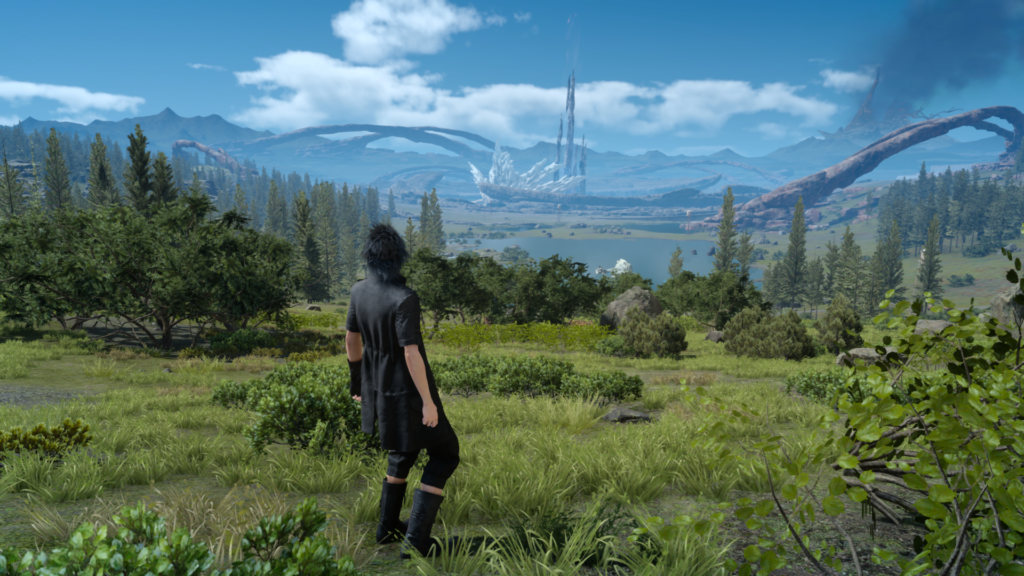
Too much ambition?
When you reach the second part of the game you have the option to go back to Lucis (the first area) and explore optional missions and hunts or follow the main quest to the city of Altissia and beyond. This was announced before the release of the game by its producer, multiple times, in fact. What we didn’t expect, however, was such an extreme and literal linear sequence: a railway.
My impression is that Square Enix tried, at some point, to populate two massive continents and a large city with stuff to do, but because of budget, time, or something else, they’ve decided to focus only on Lucis and turned these two extra areas into something more “direct”, cutting out exploration aspects within them. The final result is a weird feeling where you open the colossal maps of Altissia and Niffelheim but you can only explore a tiny fraction of them during the main quest. It’s baffling that Tenebrae is just a background image after you see it so much during Kingsglaive and read a lot of references to it inside the game.
Anyone who have played Xenogears for the original Playstation knows this wouldn’t be the first time that Square Enix (Squaresoft at that time) released a game in which a deadline hurried the second half to be completed for the sake of finishing the story arc, leaving everything else in the dust bin.
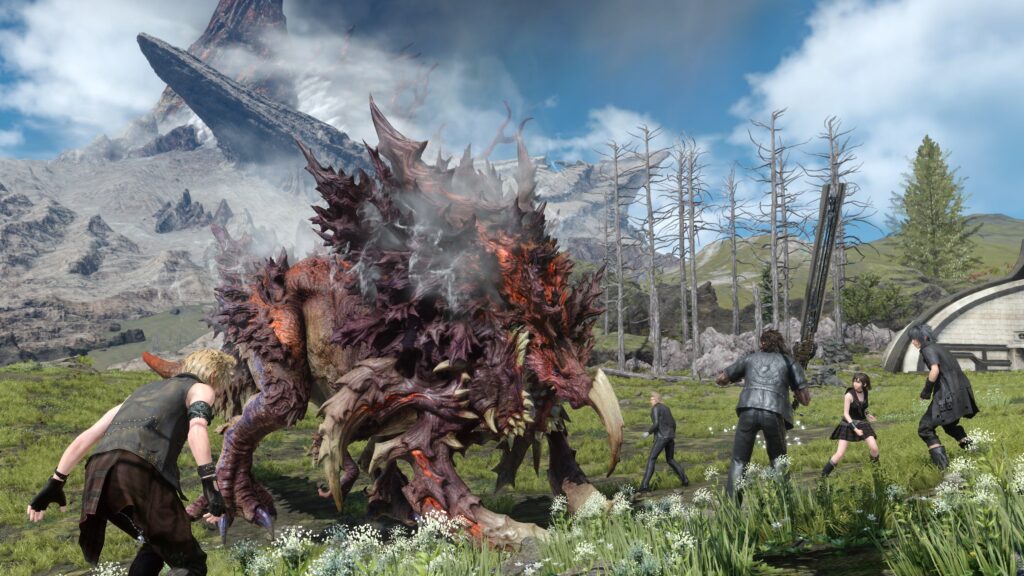
Ah, the story arc
Luckily, Final Fantasy XV has a complete main quest despite narrative plot holes and some dubious choices for events in which only a fraction is shown on screen and the rest is just narrated by a few lines of text when a new chapter starts. Noctis’ saga against the evil Niffelheim empire and his ascension to the throne of Lucis is captivating though, full of epic moments (really damn epic) and some exceptional twists. It is crowned by an unexpected and amazing ending sequence as well.
There is one big problem for its main story though: fragmentation. If you want the complete experience and want to understand better the cast that is sidelined in the game, you will need to watch both the Kingsglaive movie and the Brotherhood animated series, the latter being essential to understanding the core elements of Noctis’ three best friends.
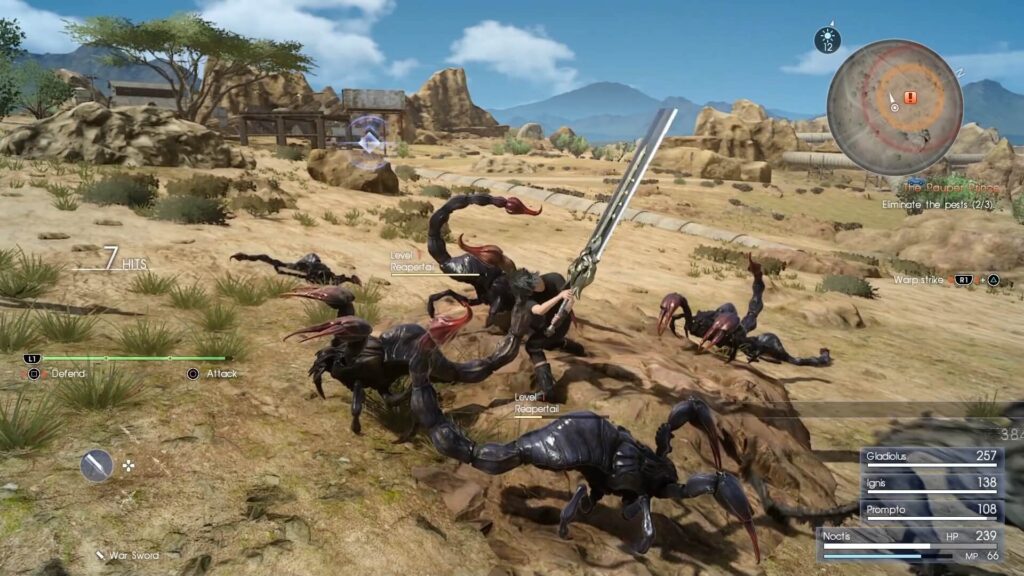
Ok. What about the gameplay?
As mentioned, plenty (or almost every) of the side quests are about killing monsters. It helps that Final Fantasy XV is excellent at that most of the time. The chaotic combat may become a bit repetitive later on, but it can always provide a new way to fight enemies at every new encounter. A pack of wolves may require a defensive combat focused on counter-attacks, slow moving foes urge for better positioning, facing flying enemies make it crucial to rely on Noctis’ warp ability, and so on. Even with only a few options to use besides the multiple weapons and the broken and poorly-developed magic system, the game ensures that you can have fun while fighting.
The leveling up itself is mostly traditional. You earn experience points by killing monsters and completing quests, but you need to spend this experience to actually level up during camping. There are also Ascension Points (AP), which you earn by a variety of activities in the game as well as from killing monsters. These APs can be used to unlock new combat options, enhance some exploring activities, amongst others, like some sort of simplified multi-purpose Sphere Grid from Final Fantasy X. Those who expected traditional RPG elements in this aspect have nothing to be worried about, Final Fantasy XV is robust enough to reward you even when you are taking part in an essentially repetitive task.
The post-game
Although the game’s system is excellent during the course of the main quest and for much of the optional content, the situation drastically changes when you reach post-game content. Starting from there, when facing more powerful enemies and bigger dungeons, the artificial intelligence of your allies become lacking to a fault, showing how much a “Gambits” system or some form of fine control would really help. Gladios, Ignis, and Prompto will die a lot and will act like confused rats when you face insane jedi-tonberries, deadly samurais, or powerful avian foes. In general, almost every post-game foe are just more boring and frustrating versions of their low-level counterparts, with bloated hit points and repetitive mechanics that can drag a single battle for far too long to be fun. Because these enemies also appear in dungeons which are basically corridors with small rooms, the camera also becomes another enemy you will be fighting constantly.
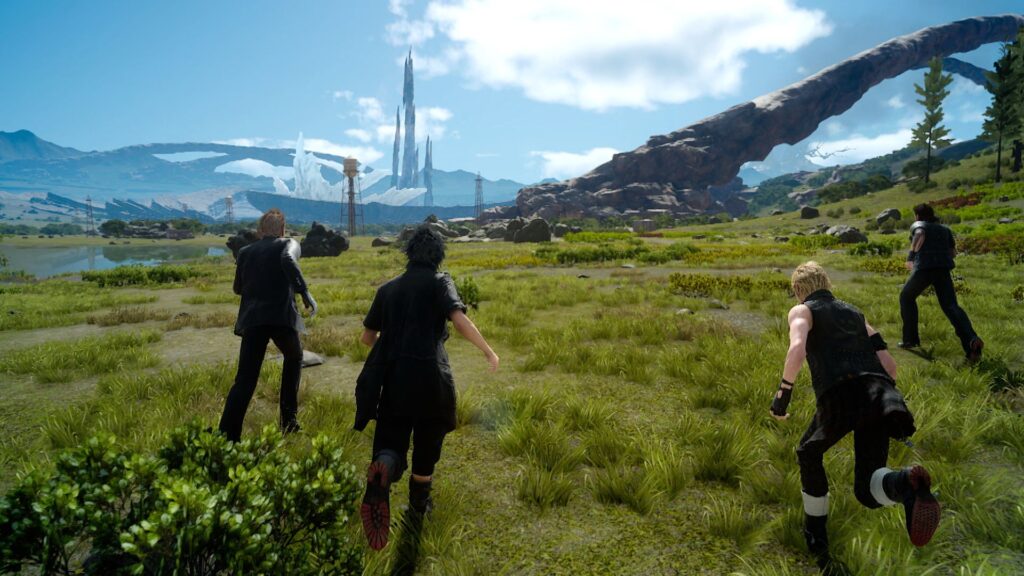
It’s a fine addition anyway
Regardless of its faults, Final Fantasy XV comes as a superb member of this long-running franchise. It delivers what fans would enjoy the most, with an intriguing world, charismatic characters, and a fun gameplay to keep you entertained for its lengthy playthrough. It is a game that welcomes a new generation of players, embracing open world aspects and achieving a high technical quality. It does suffer from its marketing model though, as it seems an incomplete game that will likely be patched and fixed for months to come and whose complete experience is scattered across multiple forms of media, such as movies, animation, and spin-off games.
The Game as a Service
Final Fantasy XV, as reviewed above, was a game released late in 2016. The next months and years, however, were keenly used by Square Enix to further improve the game, correct its mistakes, and add more stuff to do. This model as a “game as a service” certainly failed by the end, when the development of a “second season” of DLCs was abruptly shut down and the game essentially lost its ongoing support. It did, however, work to improve the foundations and make the overall experience a lot better.
These changes mostly worked in technical aspects, such as improving combat mechanics, adding options to swap active characters and control the other “bros”, introducing new vehicle options and mini-games, adding new monsters, cross-over events with other franchises and other Final Fantasy games, and the mostly bad DLCs further exploring the guys who deserved a lot more in the main game, even the amazing villain.
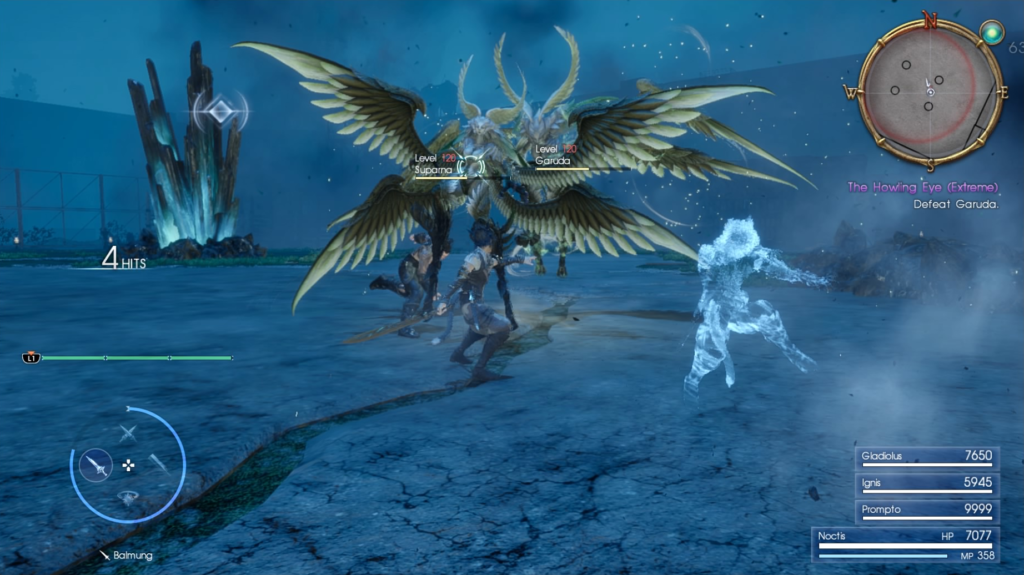
In a way, playing Final Fantasy XV since the second half of 2019 can prove to be a completely different experience than what it was back in 2016. It is not only because of the technical improvements though, there were changes even in main-quest events, adding important scenes that further explain the major plot that once had a big narrative hole that could only be answered in the message boards of the internet or by interviews with the game’s developers. These updates even overhauled an entire chapter and added a large new area at the game’s final moments.
However, despite being enhanced and corrected by such patches, Final Fantasy XV’s fragmentation still haunts the experience. On its own, it feels like an incomplete game and the two years of constant patching and updates were still not enough to cover up for this feeling. You are still required to watch Kingsglaive, watch the anime episodes of Brotherhood, the ones that came out about Ardyn, play the DLCs, and read additional information on the internet to fully understand the game. It is a pity, because, if Final Fantasy XV was a whole thing, with its amazing main cast and world building, great villain, and outstanding technical achievements, it could easily be regarded as one of the best entries in the franchise. Being as it is, however, it is just a great and enjoyable RPG to play.
Detailed Scores
-
Production
-
Content
-
Polish
-
Concept
-
Fun
